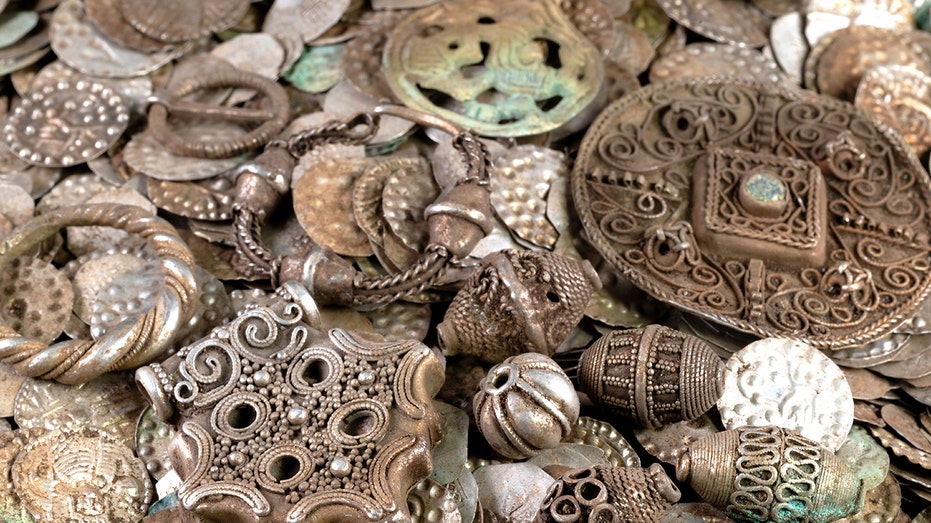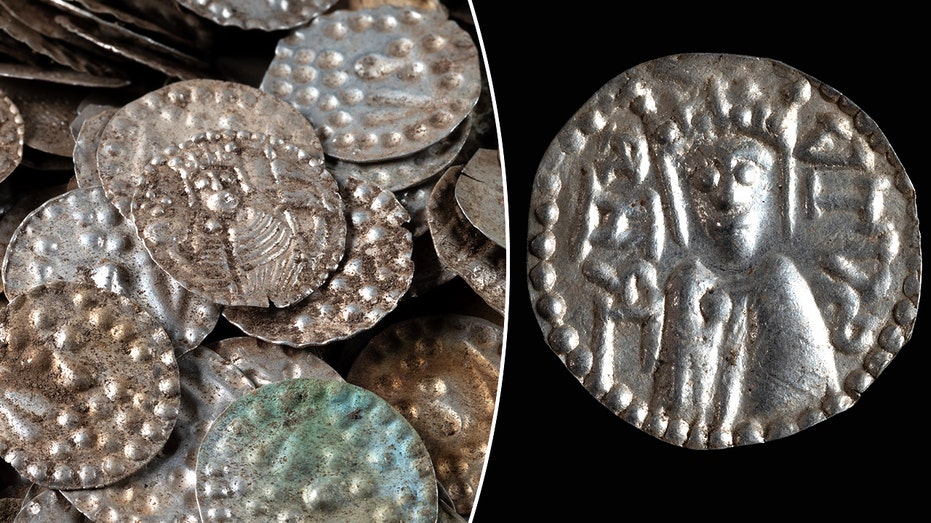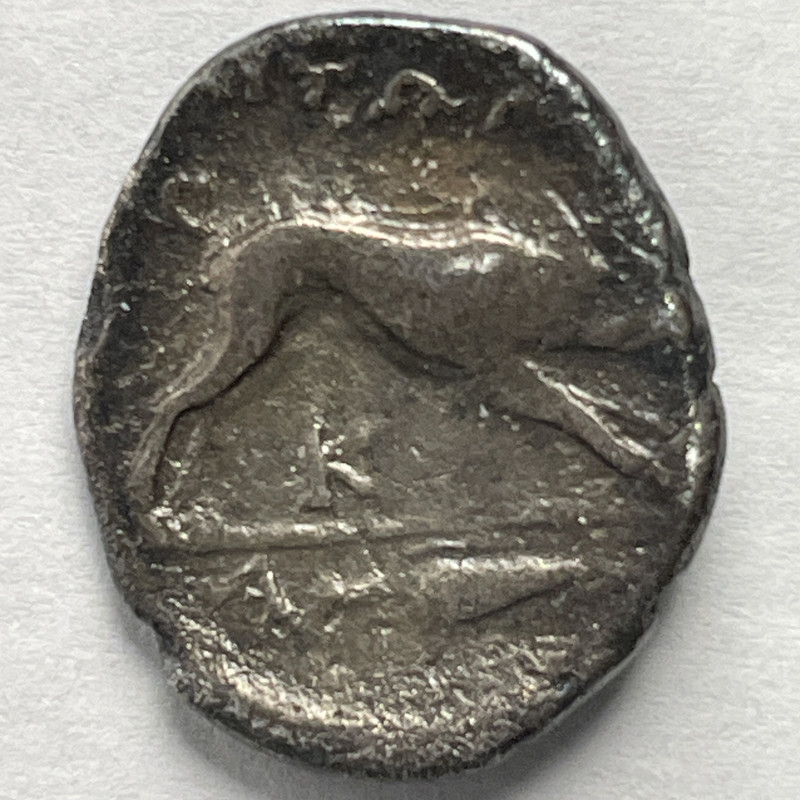
Posted on 10/29/2025 8:53:17 PM PDT by Red Badger
It won’t catch any fish, but the discovery of as many as 20,000 silver coins and pieces of jewelry dates back to the early Middle Ages.
Here’s what you’ll learn when you read this story:
A fisherman digging for worms at his summer home in Sweden instead discovered over 13 pounds of buried silver treasure.
The hoard comes from the early Middle Ages, and includes mostly coins (and some jewelry). The entire cache of silver was tucked inside a copper pot.
A Swedish fisherman searching for gooey, juicy worms to use as bait near his summer home near Stockholm instead struck something far more solid (and much less interesting to fish): a copper cauldron brimming with coins and jewelry. In total, the find comprised 13 pounds of early Middle Ages silver.
“This is probably one of the largest silver treasures from the early Middle Ages that has been found in Sweden,” Sofia Andersson, antiquarian at the Stockholm County Administrative Board, said in a translated statement. “We do not yet know exactly how many coins there are, but I believe it could be upward of 20,000.”
The thousands of silver coins come mainly from the 12th century C.E., and some were embossed with the text “KANUTUS,” which is the name “Knut” in Latin. These coins were minted during Knut Eriksson’s reign as Sweden’s king near the end of the 12th century, from around 1173 to 1195. This period of the region’s history was marked by conflict, and as a result—as Lin Annerbäck, director of Stockholm’s Medieval Museum, told the Swedish-languageDagens Nyheter—the buried treasure may have been an attempt by a wealthy family to hide their valuables during a time of uncertainty.

While the copper cauldron holding the treasure was “unfortunately not as well preserved” as the objects inside, Andersson said, those objects were in impressive condition. In addition to the coins, the discovery included silver rings, silver pendants, and pearls.
Sifting through the many coins, the experts found some unusual pieces, including so-called bishop coins that would have been minted in Europe during the Middle Ages for specific bishops. Andersson said that the new treasure features several such coins, where a bishop is depicted holding a shepherd’s crook in his right hand.
Many of the coins feature uneven cut edges and raised designs on their faces—one particularly eye-catching example features a building, which is likely a church—and some are adorned with decorative dotted borders.

The Stockholm County Administrative Board continues to work with archaeologists to both analyze the treasure and investigate the location of the discovery to see if more buried treasures await them. They are currently keeping the exact site of the find a secret from the public to protect any potential remaining artifacts.
Under Swedish law, anyone that discovers ancient silver (or gold, bronze, or another copper alloy, for that matter) must report it to the state. The state can then offer a payment to redeem the treasure. The board said that once investigations wrap, it will pass along information about the discovery to the National Heritage Board, and the board can then decide if it plans to pay compensation to the fisherman who found the hoard in order to redeem the silver.
Our best guess? He walks away with far more than worms.
Dear FRiends,
We need your continuing support to keep FR funded. Your donations are our sole source of funding. No sugar daddies, no advertisers, no paid memberships, no commercial sales, no gimmicks, no tax subsidies. No spam, no pop-ups, no ad trackers.
If you enjoy using FR and agree it's a worthwhile endeavor, please consider making a contribution today:
Click here: to donate by Credit Card
Or here: to donate by PayPal
Or by mail to: Free Republic, LLC - PO Box 9771 - Fresno, CA 93794
Thank you very much and God bless you,
Jim
Not all governments steal.
Like the US government.
“We do not yet know exactly how many coins there are, but I believe it could be upward of 20,000.”
Dubious at best...
Some of the metal work on the jewelry and baubles is really impressive, tho.
He should have kept his mouth shut. He will get some compensation but will get low balled.
I was doing the same thing and you’ll guess what I found. The Napoleonic Crown Jewels! Buried right in my back yard!
All kidding aside, I’ve told this story before. When I was in the Army in Germany our Roman Catholic chaplain was a local German priest. He had spent the war in Dachau for opposition to Nazis. He had been and was again chaplain to the Brothers of Abbey Grussau, now dissolved. The entire membership was imprisoned in Dachau by the Nazis.
After the war, the Russians used the Abbey, which is now in Poland, as headquarters for a tank division. The chaplain met with the local American military governor, a General George S. Patton. He told me that he thought Patton was cultured and educated. There was a local disused Catholic cathedral in Bad Wimpfen, since that area in Schwabenland had gone Protestant after the Thirty Years War (1618-1648). He gave the Cathedral and grounds to the survivors of the Abbey.
The area had been occupied by the Romans and was the eastern edge of the old Roman Empire. There were still some scattered Roman ruins in Bad Wimpfen. While the brothers were gardening and maintaining the grounds, they kept finding hoards of Roman coins. Father Andreas simply tossed them in the center drawer of his heavy desk. He showed me his hoard of gold and silver coins, but I wished he hadn’t. I never told anyone about the hoard for 40 years. I never had designs on it, but I was afraid of what might happen if it was common knowledge. I was especially thinking about certain GIs I knew.
Abbey Grussau is no more. The last survivor is gone to his reward, the Cathedral, lovingly restored by U.S. Army engineers out of Heilbronn using Army equipment (with General Patton’s blessing) has been taken over by the local Baden-Wurtenburg Land government, for the people, doncha know.
The Swedish government will likely give him the current market value of the silver content.
13 lbs = 5896.7 grams = 189.58 Troy oz X 47.89 USD per oz = $9079.00
Not a bad ‘catch’ for a day of fishing.............
But did the fisherman find any worms?
Don’t make me post the “open a new bank account” joke again. 😊
Thanks, great info! It’s not rare to see ancient coins that are very small diameter, but yeah, the 20K does seem high.
🤔 What joke?................
A young woman entered a bank, went to the teller with a grocery bag filled with bills. “I’d like to open a savings account please.” The teller took one look inside the bag, and asked the manager to come over. He looked in, then asked the young woman to follow him to his office. They sat down there.
“Let’s get started. Any idea how much you have in here?”
“About $879,000.”
“Wow! This needs to be safe and secure in our bank, not in some old paper bag. Did you hoard all this money by yourself?”
“No, my sister hoard half of it.”
😁😂🤣😂😁🙄........................
You ain't lying, this is a big one compared to some of the other ancient greeks I own. 
Wow.


Nicely preserved details!
Ooh, and btw, just read up on the Aetolian League. They were, uh, nimble in their political, uh, okay, they were a bunch of turncoats. 😆
https://www.britannica.com/topic/Aetolian-League
What is this - using CE instead of AD. Anno Domini has been used for years and has been universally accepted. I do not care of the venerable Association of Academic Arses has decided to use CE. Let them but I won’t fund them.
Disclaimer: Opinions posted on Free Republic are those of the individual posters and do not necessarily represent the opinion of Free Republic or its management. All materials posted herein are protected by copyright law and the exemption for fair use of copyrighted works.